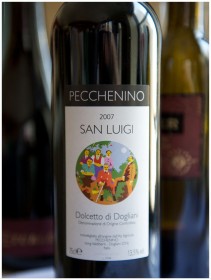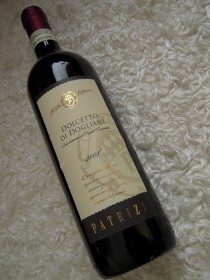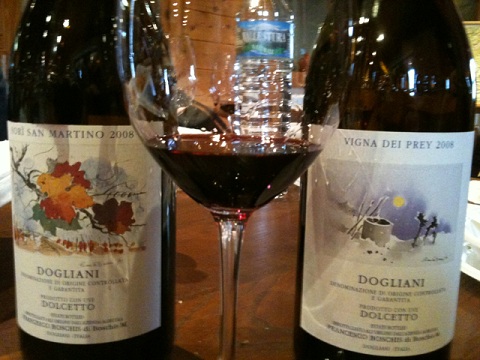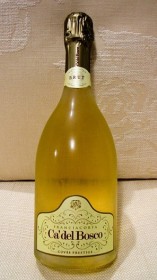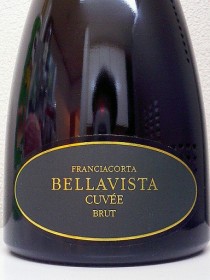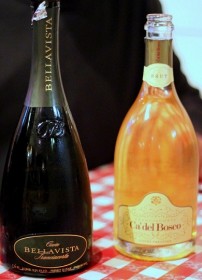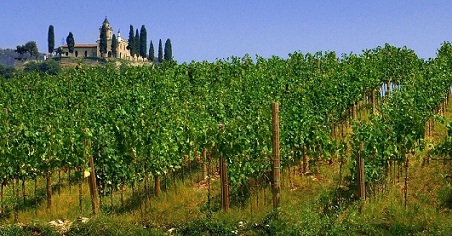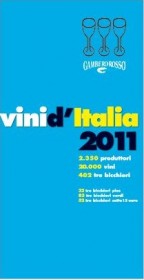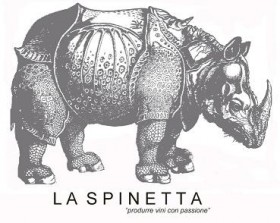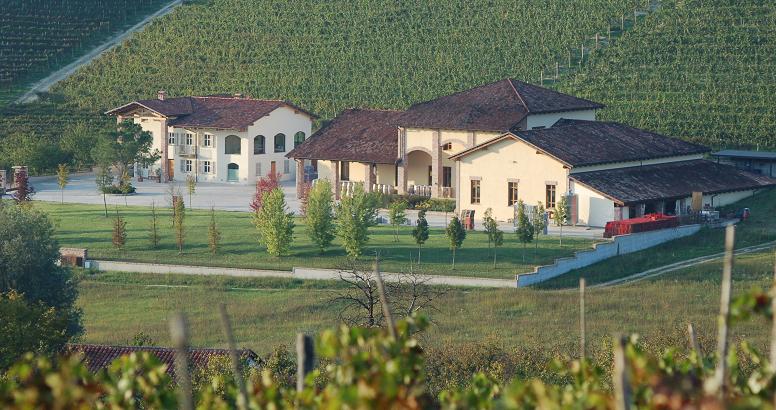Our wine guru Gary Chevsky enjoyed a tasting event for Italian red and white wines back in August, and shared his views with us:
“At the Chambers & Chambers trade tasting this week, I had a chance to visit and revisit many wines from all over Italy. Gourmet thin-crust pizzas from Lulu restaurant in the SOMA district of San Francisco complemented what seemed like 80-100 wines. About half the wines at the tasting were imported through Dalla Terra, founded by Brian Larky, a very funny dude. But funny is obviously not all he is – because Dalla Terra is a clever concept. They essentially eliminate one of the tiers in a 4-tier wine import distribution system, through their Winery Direct program.
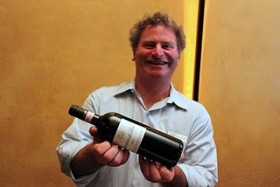 In 1989 Brian returned to the U.S. after five years as winemaker at one of my favorite sparkling wine producers in the world – Italian estate Ca’del Bosco, who makes the top Franciacorta (in Lombardy) that easily rivals top Champagne. Even Ca’del Bosco’s entry-level cuvee “Prestige” is a perennial great value sparkler. Brian founded Dalla Terra Importers in 1990. Before working in Italy, he’d earned a UC Davis Fermentation Sciences degree and held production jobs in Napa Valley wineries such as Far Niente and Domaine Chandon. Don’t be fulled by the effusive smile – the dude is clearly not just a funny dude. Whereas a usual importer markup could be 30-40%, Dalla Terra’s fee is only 15%, and that’s enough for them to run a profitable business for the past 20 years. That’s because unlike a traditional importer who has to buy and hold the inventory from the producer, Dalla Terra are a broker.
In 1989 Brian returned to the U.S. after five years as winemaker at one of my favorite sparkling wine producers in the world – Italian estate Ca’del Bosco, who makes the top Franciacorta (in Lombardy) that easily rivals top Champagne. Even Ca’del Bosco’s entry-level cuvee “Prestige” is a perennial great value sparkler. Brian founded Dalla Terra Importers in 1990. Before working in Italy, he’d earned a UC Davis Fermentation Sciences degree and held production jobs in Napa Valley wineries such as Far Niente and Domaine Chandon. Don’t be fulled by the effusive smile – the dude is clearly not just a funny dude. Whereas a usual importer markup could be 30-40%, Dalla Terra’s fee is only 15%, and that’s enough for them to run a profitable business for the past 20 years. That’s because unlike a traditional importer who has to buy and hold the inventory from the producer, Dalla Terra are a broker.
The concept is relatively common with domestic wines, but quite innovative (and difficult to implement) with imports. They never buy the wine – they connect the winery with a local US state distributor (like Chambers & Chambers), so they never have to shell out the big bucks necessary to hold the wine. Nor do they take the risk of inventory not selling. That is, the risk sits with the winery; therefore it’s reasonable to assume that the winery would retain a larger piece of the pie by quoting a relatively higher price to the distributor than they would to an importer. It’s hard to say though. I went to Wine-Searcher.com – the world’s most trusted wine comparison shopping engine – to compare local US prices to those on the Italian market of some of Dalla Terra’s wines, such as Casanova di Neri and Vietti. I found there is about a 40-50% markup in US over Italy. I then looked at some other high-end Italian producers, such as Il Poggione, Fattoria di Felsina, and Marcarini imported though Southern Wine & Spirits, Wine Warehouse, and Empson USA respectively. US prices were 40% to 125% above the Italian prices. So the price benefits of Dalla Terra were not obvious to me, but this is by no means a scientific study, and I welcome comments from folks in the wine industry. In an interview, Brian told me that Dalla Terra have about 18 producers in their all-Italian portfolio, and in 20 years they haven’t lost one. “That speaks volumes for the type of business partner we are and the type of business we bring.” said Brian.
Here are the wines I particularly enjoyed at the tasting.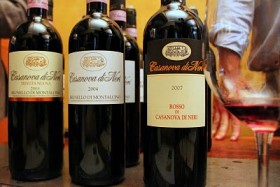
The Reds
Casanova di Neri Brunello di Montalcino 2004. This was their basic “white label” Brunello. (The 2001 Casanova di Neri Brunello made a splash with their higher-end “Tenuto Nuova” cuvee by being Wine Spectator’s #1 wine of the year in 2006.) Had this basic Brunello at the tasting and, more importantly, at a dinner next day. The wine is from the excellent 2004 vintage and is showing very well – juicy fruit, good acidity, tasty tannins. Exploding with aromas and fruit flavors, the wine is light enough to even go with fish, thanks to the excellent acidity and medium body. Delicious.
Marchesi di Gresy Barbaresco “Martinenga” 2006. Sweet, charming, red fruit, beautiful strawberry / cranberry color, gentle Nebbiolo texture, and the most accessible of any 2006 Barbarescos/Barolos I’ve tried so far. 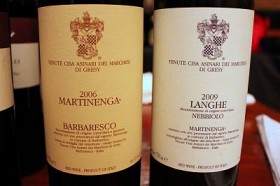
Vietti Barolo “Castiglione” 2006 – structured with slight menthol character, complex. It was the best wine match with the gourmet sausage pizza. The 2006’s are starting to open up. The 2005 “Brunate” didn’t have the menthol, but was also good. Dependable, top producer of Barolo, Vietti’s Barolo Lazzarito 2005 impressed me at the 2010 Tre Bicchieri tasting earlier this year. Their Barbera and Arneis are good too.
Vietti Barbera d’Alba “Scarrone Vigna Vecchia” 2006. Wonderfully balanced, rich, plush Barbera that tips to the much-maligned modern style, yet the delicious factor is undeniable. The most expensive Barbera I’ve ever seen ($75-100 retail). Rare, from a tiny lot in the prime Nebbiolo-caliber vineyard in Castiglione. More of a curiousity item, in my opinion, since in that price range, the wine has to be hand-sold to affluent buyers, looking for something “different”, and will be competing with high-end Barolos and Brunellos. For those who are willing to shell out big bucks for “something different”, there are options in Taurasi (from Campania), Sagrantino di Montefalco (from Umbria), and Etna Rosso (from Sicily) that come to mind before Barbera. Good wine, tough sell. 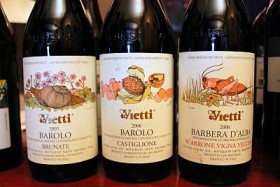
Roccolo Grassi Valpolicella Superiore “Roccolo Grassi” 2007. Single vineyard. Solid.
Roccolo Grassi Amarone “Selezione Antonio Castagnedi” 2006. All three of the Roccolo Grassi wines (including a white, mentioned below) were excellent. A producer to pay attention to. The 16-17% alc. the Amarone didn’t taste hot at all.
Selvapiana Chianti Rufina Riserva “Bucerchiale” 2006 – from a great vintage in Tuscany, excellent structure and texture, medium body. The detractor was notable heat on the palate – and lo and behold, the wine was a whopping (for a Chianti) 14-15% alc.
Cherchi Cannonau di Sardegna Rosso 2009 – good example of the native Cannonau grape of Sardinia. Very drinkable and food-friendly.
Vignalta “Gemola” 2004 – “Super-tuscan” from Veneto! (blend of Merlot and Cab Franc) – flagship of the Vignalta portfolio, well-balanced fruit/veggie, right-bank-Bordeaux like. Liked it both times. Nice effort. 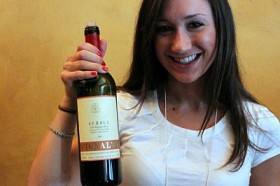
The Whites
Italian whites are a myriad of grape varietals and regions. Generally unoaked or low-oaked, crisp, food friendly, and quite interchangeable. I find Soave (from Veneto), Arneis (from Roero, Piedmont) and Ribolla Gialla (from Friuli) generally to my highest liking. But I enjoy many others depending on the particulars.
Vietti Arneis 2009 – good.
Roccolo Grassi Soave “La Broia” 2007. All three Roccol Grassi’s wines (including two reds mentioned above) were good.
Inama Soave Classico Superiore “Vigneti di Foscarino” 2007. More generous (but tasteful) oak treatment made this wine richer, more complex, more serious than a typical Soave, clearly showing the range of the Garganega grape of which Soave is made. Very good.
Marco Felluga Collio Bianco “Molamatta” 2008. Blend of Pinot Bianco, and the native Tocai Friulano and Ribolla Gialla.
A tasting like this reminds me how much I love Italian wine. And the photos of those pizzas next to the above-mentioned vino make me salivate. It’s almost lunch time here. I’m hungry. How about you?”
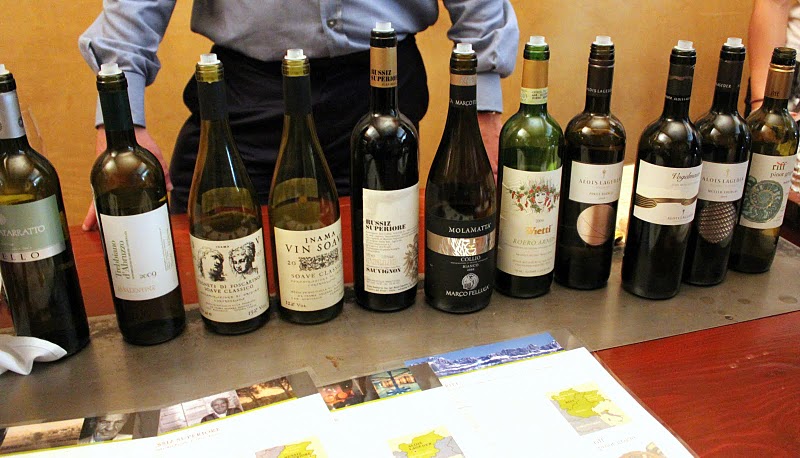
Tags: Amarone, Arneis, Barbaresco, Barbera d'Alba, Barolo, Brunello, Ca'del Bosco, Casanova di Neri, Cherchi, Dalla Terra, Franciacorta, Marchesi di Gresy, Marco Felluga, Piedmont, Roccolo Grassi, Soave, Valpolicella, Veneto, Vietti, Vignalta
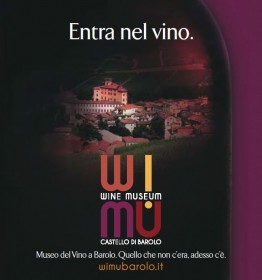 But the museum is not focused on the history and details of making Barolo. It seems like the main goal is to get visitors involved and engaged, and less to inform them. There is little factual information here and visitors looking to get an in-depth knowledge of winemaking are likely to be disappointed.
But the museum is not focused on the history and details of making Barolo. It seems like the main goal is to get visitors involved and engaged, and less to inform them. There is little factual information here and visitors looking to get an in-depth knowledge of winemaking are likely to be disappointed.